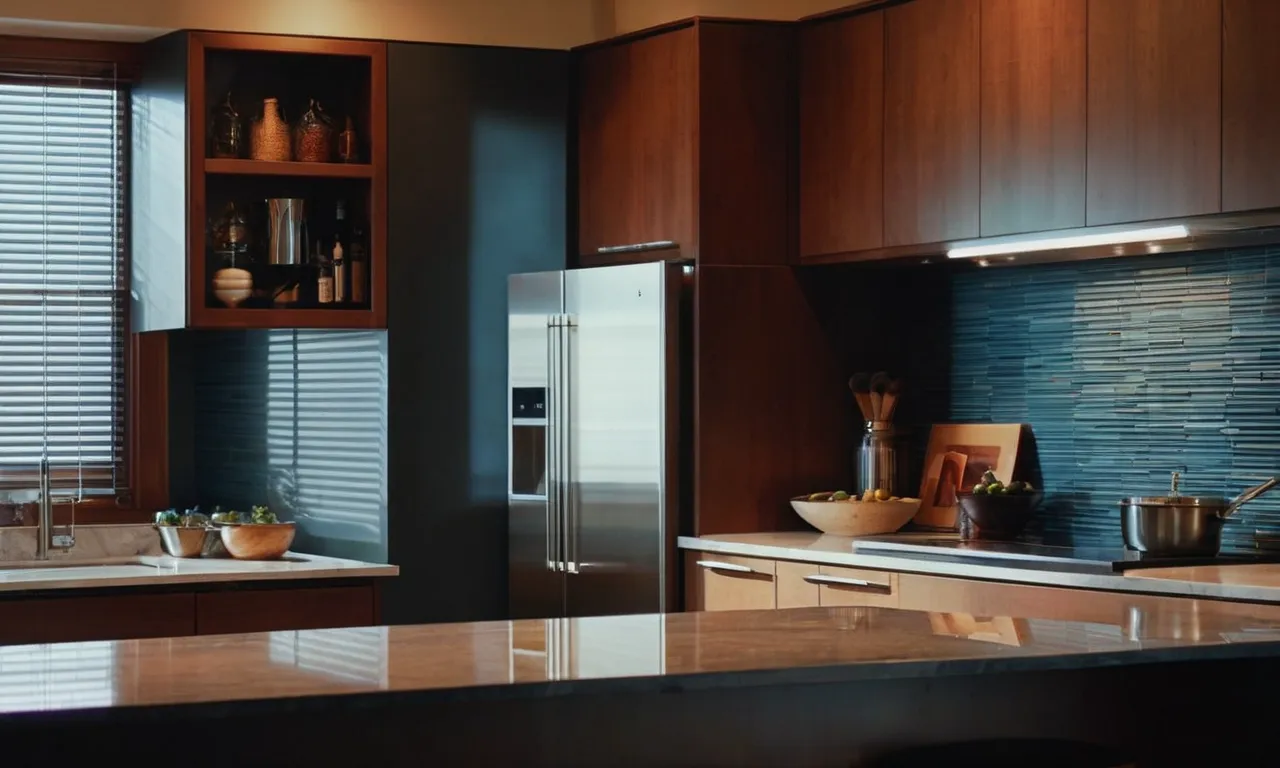What Is The Standard Space Between The Counter And Upper Cabinets?
If you’re looking to remodel your kitchen or build a new one, one of the many decisions you’ll have to make is how much space to leave between the counter and the bottom of the upper cabinets. This gap, known as the ‘toekick’, impacts the look, feel, and functionality of your kitchen.
If you’re short on time, here’s a quick answer: the standard space between the counter and upper cabinets is typically 18-24 inches. This allows enough room for most appliances and activities, while keeping upper cabinets within easy reach.
In this comprehensive guide, we’ll dig into all the details around determining the ideal counter-to-cabinet dimension for your kitchen. We’ll look at the different factors to consider, standard recommendations, and tips for customizing this space to best suit your needs and style.
Standard Recommendations for Counter-to-Cabinet Spacing
When it comes to the space between your kitchen counter and upper cabinets, there are some standard recommendations to consider. These guidelines ensure that you have enough room to comfortably work in your kitchen while keeping everything within easy reach.
Let’s explore these recommendations in more detail.
18-Inch Minimum
The minimum recommended space between the counter and upper cabinets is typically 18 inches. This measurement allows for enough clearance to work comfortably and access your cabinets without any obstructions.
However, keep in mind that this is the bare minimum, and depending on your needs and preferences, you may want to consider a larger space.
20-24 Inches for Most Kitchens
For most kitchens, a spacing of 20 to 24 inches between the counter and upper cabinets is often preferred. This range provides a balance between functionality and aesthetics. It offers enough space for you to work comfortably and store items in your cabinets, while also maintaining a visually pleasing look.
Consider Your Height and Activities
When determining the ideal spacing between your counter and upper cabinets, it’s important to consider your height and the activities you typically engage in while working in the kitchen. If you are taller, you may prefer a larger space to avoid feeling cramped.
Likewise, if you frequently use larger appliances or cookware, you may want to allow for additional clearance to accommodate them.
Accommodate Appliances
Another factor to consider when determining the spacing between your counter and upper cabinets is the presence of appliances. If you have appliances such as a microwave, range hood, or under-cabinet lighting, you’ll need to ensure that there is enough space for them to fit properly.
Consult the manufacturer’s recommendations for each appliance to determine the required clearance.
Measuring from Counter or Floor?
When it comes to determining the standard space between the counter and upper cabinets, there are two main approaches: measuring from the counter and measuring from the floor. Both methods have their advantages and considerations, so let’s explore each one in more detail.
Counter-to-Cabinet Measure
One way to determine the space between the counter and upper cabinets is by measuring directly from the counter. This method is commonly used in kitchen design and renovation projects. To get an accurate measurement, start by measuring the distance from the counter’s surface to the bottom of the upper cabinets.
This measurement will give you the vertical space available for appliances, such as microwaves or coffee makers.
It is important to consider the height of the appliances you plan to install when measuring from the counter. Some appliances, like microwaves or toaster ovens, may have specific height requirements. Make sure to consult the manufacturer’s guidelines or specifications to ensure proper clearance between the countertop and the appliances.
Floor-to-Cabinet Height
Another approach to determining the space between the counter and upper cabinets is by measuring from the floor. This method is particularly useful if you’re working with uneven or irregular countertops.
By measuring from the floor, you can ensure that the cabinets are installed at a consistent height, regardless of any variations in the countertop surface.
When measuring from the floor, it’s essential to take into account any base cabinets or toe kicks that may be present. These elements can affect the final height of the upper cabinets. Also, consider the height of the average person in your household to ensure that the cabinets are positioned at a comfortable and accessible height.
Relationship Between the Two
The measurements obtained from both the counter and floor approaches are interconnected. The distance between the counter and upper cabinets should be consistent throughout the kitchen to maintain a cohesive and visually appealing design.
Therefore, it’s crucial to establish a harmonious relationship between the two measurements.
Typically, the space between the counter and upper cabinets ranges from 18 to 20 inches. This range allows for both functionality and aesthetics, providing enough room for countertop appliances and allowing easy access to the upper cabinets.
However, it’s important to note that these measurements can vary depending on individual preferences, kitchen layout, and the specific needs of the homeowner.
For more detailed guidelines and information on kitchen cabinet measurements and design principles, you can visit reputable websites such as This Old House or HGTV.
Factors to Consider When Deciding on Spacing
When it comes to the standard space between the counter and upper cabinets, there are several factors to consider. These factors ensure that the spacing is not only aesthetically pleasing but also functional and ergonomic. Let’s take a closer look at some of these key considerations.
Counter Depth
The depth of your countertop plays a crucial role in determining the spacing between the counter and upper cabinets. The standard depth for kitchen countertops is typically around 24 inches. However, this measurement can vary depending on your specific needs and preferences.
If you have a deeper countertop, you may need to adjust the spacing accordingly to create a balanced and visually appealing look.
Drawer and Appliance Clearance
Another essential factor to consider is the clearance required for your drawers and appliances. It’s important to ensure that there is enough space between the counter and upper cabinets to allow for the smooth opening and closing of drawers and doors.
Additionally, you’ll want to make sure there is ample clearance for any appliances, such as microwaves or toasters, that may be installed under the upper cabinets. This will not only prevent any potential damage but also provide ease of use in your kitchen.
Comfort and Ergonomics
Comfort and ergonomics should never be overlooked when deciding on the spacing between the counter and upper cabinets. The height of your upper cabinets should be carefully considered to ensure that they are within easy reach and don’t require excessive stretching or bending.
Creating a comfortable and ergonomic workspace will make your time in the kitchen more enjoyable and efficient.
Aesthetic Preferences
While functionality and ergonomics are important, aesthetic preferences also play a significant role in determining the spacing between the counter and upper cabinets. Some homeowners may prefer a sleek and streamlined look with minimal spacing, while others may opt for a more open and airy feel.
Ultimately, the decision on spacing should align with your personal style and the overall design of your kitchen.
When determining the standard space between the counter and upper cabinets, it’s essential to consider factors such as counter depth, drawer and appliance clearance, comfort and ergonomics, and aesthetic preferences.
Taking these factors into account will help you create a well-designed and functional kitchen space that meets your needs and reflects your personal style.
Tips for Customizing Counter-to-Cabinet Spacing
Add Architectural Interest
When customizing the counter-to-cabinet spacing in your kitchen, one important aspect to consider is adding architectural interest. By varying the space between the counter and upper cabinets, you can create a visually appealing design.
For example, leaving a larger gap between certain cabinets can be used to showcase decorative items or create a focal point in the kitchen. On the other hand, a tighter spacing can give your kitchen a sleek and modern look.
Experimenting with different spacing options can help you achieve a unique and personalized kitchen design.
Maximize Storage
Another factor to consider when customizing the counter-to-cabinet spacing is maximizing storage. Depending on your needs, you may want to leave more space between the counter and upper cabinets to accommodate larger items such as appliances or tall kitchen gadgets.
This additional space can provide you with more storage options and make it easier to access and organize your kitchen essentials. On the other hand, if you have limited space, you may need to optimize the spacing to ensure every inch is utilized efficiently.
Increase Clearance for Tall Cooks
For taller individuals, increasing the clearance between the counter and upper cabinets can be beneficial. This extra space allows for more comfortable cooking and meal preparation, as it prevents constant bending or hitting of the head on the upper cabinets.
By customizing the spacing to accommodate taller cooks, you can create a kitchen that is both functional and comfortable for everyone in your household.
Accommodate a Kitchen Island
If you have a kitchen island or are planning to incorporate one into your kitchen design, customizing the counter-to-cabinet spacing becomes even more crucial. The spacing between the island and upper cabinets should be carefully considered to ensure there is enough room for movement and functionality.
Additionally, the spacing between the island and the surrounding cabinets should be consistent and balanced to maintain a cohesive and visually pleasing kitchen layout.
Special Considerations for Different Kitchen Layouts
When it comes to designing a kitchen, one of the key considerations is the space between the counter and upper cabinets. This distance plays a crucial role in ensuring functionality and aesthetics. However, the ideal space can vary depending on the kitchen layout.
Let’s explore some special considerations for different kitchen layouts:
Galley Kitchens
Galley kitchens are characterized by two parallel countertops with a narrow space in between. In these layouts, it’s important to maximize every inch of available space. Therefore, the standard space between the counter and upper cabinets in galley kitchens is typically around 15 to 18 inches.
This allows for easy access to both the countertop and upper cabinets, while still maintaining a visually pleasing balance.
L-Shaped Kitchens
L-shaped kitchens feature two countertops that meet at a right angle, forming an L-shape. The space between the counter and upper cabinets in these layouts can vary depending on the specific design and dimensions. However, a general guideline is to maintain a distance of around 18 to 20 inches.
This provides enough room for countertop appliances and allows for comfortable working and storage space.
U-Shaped Kitchens
U-shaped kitchens have countertops that form a U-shape, providing ample working and storage space. In these layouts, the space between the counter and upper cabinets is typically around 18 to 24 inches.
This wider gap allows for better access to the countertop and upper cabinets, making it easier to navigate and work in the kitchen.
Peninsula and Island Kitchens
Peninsula and island kitchens are known for their additional countertop space and seating options. The space between the counter and upper cabinets in these layouts can vary depending on the specific design and purpose of the peninsula or island.
Typically, a distance of around 12 to 15 inches is maintained to ensure easy access and a visually appealing balance. However, it’s important to consider the overall functionality and design of the kitchen when determining the exact measurements.
Remember, these are general guidelines and your specific kitchen layout may require adjustments based on your personal preferences and needs. Consulting with a professional kitchen designer can help ensure that the space between the counter and upper cabinets is optimized for both functionality and aesthetics.
Conclusion
When deciding how much space to leave between your counter and upper cabinets, there are lots of factors to take into account. Following general guidelines around 18-24 inches is a good starting point for most standard kitchen layouts and heights.
But don’t be afraid to customize this dimension based on your specific needs and style preferences.
Balancing form and function is key. Make sure to leave enough clearance for opening appliances and performing kitchen tasks comfortably, while also considering the visual impact and storage capacity. With some thoughtful planning upfront, you can create a toekick space that both looks great and works perfectly for you.







